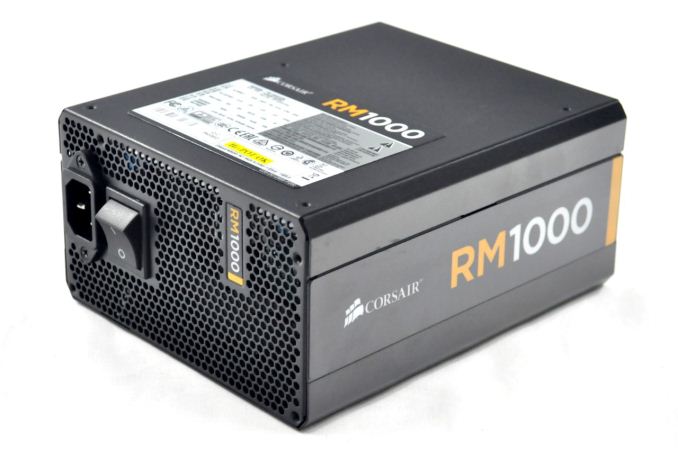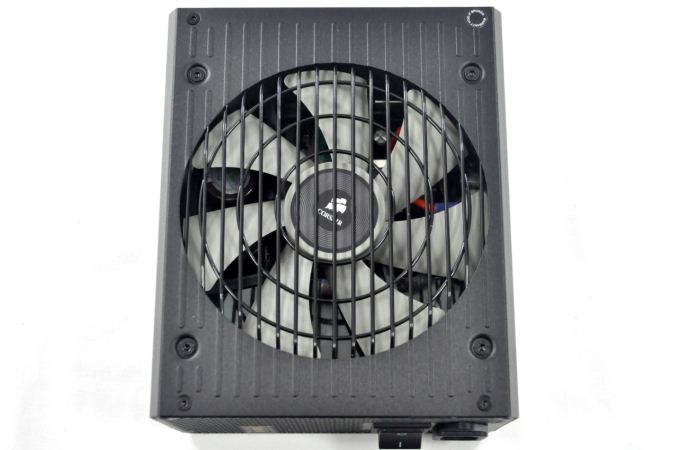Corsair RM1000 Power Supply Review
by E. Fylladitakis on April 24, 2014 6:00 AM EST- Posted in
- Cases/Cooling/PSUs
- Corsair
- PSUs
- RM Series
Conclusion
Most of Corsair's products are focused on specific target groups and the RM PSU series is targeted towards advanced users who appreciate silence above all else. The RM1000 that we reviewed today is the most powerful unit of the series, capable of feeding very high performance gaming systems. It's actually rather strange that the series would expand up to a 1000W unit; it is not impossible to build a system that would require such a massive level of power while remaining quiet, but it would be bulky and very costly. Nevertheless, if you are trying to build a very powerful and low-noise system, the RM1000 is there to lend a hand. Moreover, even though the RM1000 is focused on low-noise operation, it does not mean that Corsair neglected its performance or appearance.
Visually, the subtle modifications, such as the chamfered edges and the rimmed bottom, make the fully modular RM1000 aesthetically pleasing without standing out too much. The all-black, sleeveless cables are another attraction of the unit, as I feel they are visually superior to sleeved color-coded cables; however, because of their ribbon-like design with the wires bonded together, the cables of the RM1000 are a bit stiffer to turn and route than typical cables.
The electrical performance of the RM1000 is very good and we expected nothing less from a CWT platform, which usually are very well designed and made. The RM1000 is highly efficient and remains so even when the ambient temperature increases significantly, which is infrequent even for very advanced designs. It also provides good quality power, with low voltage ripple even under heavy stress.
Where the RM1000 could use some improvement is on thermal performance, as it seems unwise to heavily tune a 1000W unit with such small heatsinks towards low-noise operation. Despite that, the RM1000 kept performing very well during our testing, even with the ambient temperature much higher than its 40 °C rating, but the temperature of the unit increased to uncomfortable levels and the cooling system could not do anything to react because the fan's speed was already maxed out.
When it comes to quality, the Corsair RM1000 scores very well, yet there is room for improvement. The unit is very well made, with an excellent soldering and assembly job. Most primary components come from very reputable manufacturers, such as Nippon Chemi-Con and TAICON. However, some components come from manufacturers with a mediocre reputation, such as the CapXon capacitors on the secondary side of the transformer. Corsair must know what they are doing though, as they are covering the RM1000 with a five-year warranty.
The MSRP of the RM1000 is $199.90 but we found it online for $169.99 after rebate. It's not the cheapest 1000W unit with an 80 Plus Gold certification, but considering the quality and performance of the PSU, the price is justifiable. If you are the kind of user that wants a really powerful PSU tuned for low-noise operation, the RM1000 should find its way into the top few spots of your shortlist.












55 Comments
View All Comments
tynopik - Thursday, April 24, 2014 - link
where's the cart with cable lengths and connector spacings?poohbear - Thursday, April 24, 2014 - link
so, in 2014, what kind of system actually needs 1k wts? CPUs and Graphics cards are as power efficient as ever, so what are people doing with these 1k psus? My GTX 670s in SLI pull 300wts together under load, the newer graphics cards are even more power efficient, so what gives?peterfares - Friday, April 25, 2014 - link
mining coinsmeacupla - Saturday, April 26, 2014 - link
You're not supposed to load it up fully, because efficiency drops off.Generally, what you want to do is load up the PSU so that it's operating near peak efficiency where the computer is going full tilt. If you run an overclocked i7 and a pair of 780 cards, I think that gets you into the 600W range, or 60% load for this PSU, which is around the peak efficiency for it.
Antronman - Saturday, April 26, 2014 - link
2-way water OC SLI/CF with high-end cards+ CPU OC on water.600-700w power draw easily, and then another 80w+ for the monitor, plus 10w for each USB device.
ba-bam, you need a 1000w PSU.
royalcrown - Monday, April 28, 2014 - link
Except the monitors don't run off the psu ;)tabascosauz - Friday, April 25, 2014 - link
I had hoped that the higher wattage RMs (850W and now 1000W) would trade CapXon/TAICON/Teapo caps for Chemicon/Rubycon ones and the zero rpm fan profile for an even quieter fan, but I guess one can't always get what he wishes for.The thing is, at this price range there's just so much competition. You have absolutely stunning 80+ Gold and Platinum 1KW+ platforms from Super Flower, Seasonic, and Delta that don't miss a beat when it comes to high quality components and impeccable solder jobs. This makes the RM a lot less attractive (well, it does look nice on the outside but most other KW+ units also look nice).
YoloPascual - Friday, April 25, 2014 - link
^+1This psu has a zero rpm mode. The heat will f**k up those capxon and taicon. RM1000w is $190 now in newegg, EVGA G2 1000w $200 , Cooler Master V1000w $210.
Those who got more than 2 gpus will not bother to expend 10-20$ more if they can a much better psu. IF those people know more, not just brand names.
jonnyGURU - Friday, April 25, 2014 - link
I disagree. Not only are these caps rated at 105°C, but the temperatures inside the PSU don't get anywhere near that. Remember that the life of the cap increases exponentially the cooler it is from it's max rating.Also, Japanese caps are quite over-rated. They're not even made in Japan anymore (they're just Japanese brand) and the Chinese are using the same Japanese electrolyte and aluminum that the Japanese brands are using.
tabascosauz - Friday, April 25, 2014 - link
Well, manufacturers can obviously RATE their caps at the temperature they want them to be rated, but not all of them will deliver. Teapo has been in the game for quite a bit of time and now it's pretty much agreed that they are capable of delivering on the same level as the Japanese ones, but it's the TAICON and CapXon ones that are a little less sure.I do agree that even with a zero rpm fan mode, there's still a pretty capable fan on the RM. That's the reason why I would never buy a Seasonic fanless PSU for any reason. I must say that I haven't seen many 1000+ units from CWT and don't know how they fare (from the soldering jobs that they do I would say that CWT needs some more experience in the high end market, although it shouldn't really affect performance), Seasonic, Delta and to a certain extent Super Flower can claim their superiority here.
Are you OklahomaWolf or are you just a fan of jonnyGURU? That site is one of my go-to places for an education on PSUs, aside from TPU. All the others are pretty much junk.